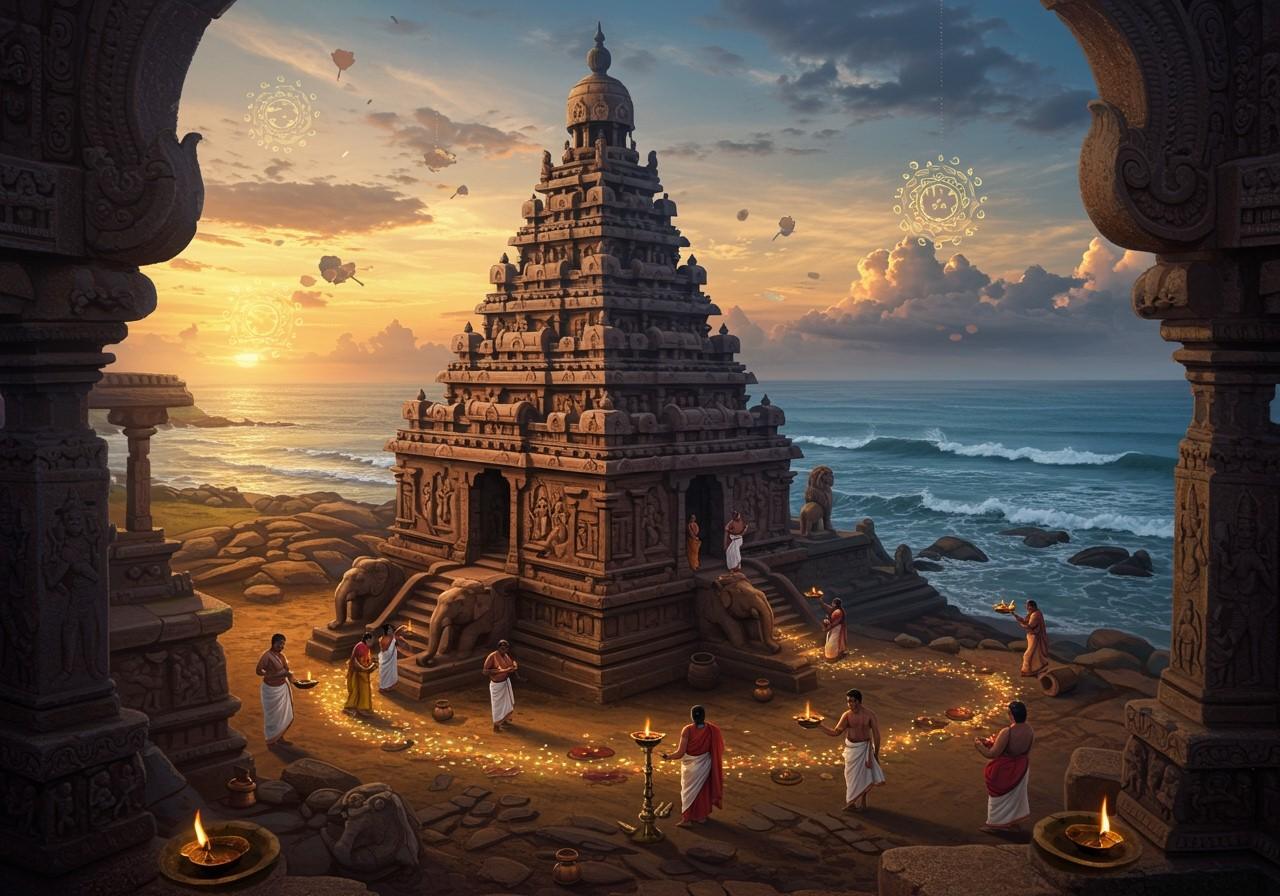
The Pallava dynasty, reigning from 275 CE to 897 CE, left an enduring mark on South India’s spiritual landscape. Their innovative temple architecture, intricate rituals, and captivating art continue to inspire awe and reverence. This article delves into the Pallava’s contributions, exploring their architectural marvels, the significance of rituals in their society, and the lasting influence of their art on religious practices. By understanding these aspects, we gain a deeper appreciation for how the Pallavas shaped the spiritual fabric of South India.
Pallava Dynasty Contributions to Temple Architecture
The Pallavas pioneered a transition in temple construction, moving from brick and timber to the use of stone. This innovation laid the foundation for medieval South Indian architecture. Their rock-cut temples and monolithic structures stand as testaments to their ingenuity and mastery of stone carving.
- Shore Temple at Mahabalipuram (UNESCO World Heritage Site): Constructed during Narasimhavarman II’s reign (around the 7th century CE), this temple showcases a unique blend of Dravidian and rock-cut styles. Its intricate carvings and strategic seaside location make it an architectural marvel.
- Descent of the Ganges rock carvings at Mamallapuram: This impressive open-air bas-relief, also known as Arjuna’s Penance, depicts a vibrant scene from Hindu mythology. It showcases the Pallavas’ skill in capturing dynamic narratives in stone.
- Kailasanathar Temple in Kanchipuram: Built by Rajasimha in the late 7th century CE, this temple is renowned for its intricate carvings, detailed iconography, and use of granite. It represents a significant advancement in structural temple design.
- Development of Vimana Architecture: The Pallavas significantly developed the vimana (tower) architecture, a hallmark of South Indian temples. These towering structures, adorned with sculptures of deities and mythological scenes, became a defining feature of temple design.
Significance of Rituals in Pallava Society
Rituals played a central role in Pallava society, reflecting their profound spiritual beliefs. These practices, deeply embedded in daily life, fostered a strong sense of community and connection with the divine.
- Daily Temple Rituals: Elaborate ceremonies like Abhishekam (ritual bathing of deities) and Alankaram (decoration of deities) were integral parts of daily worship. These rituals involved specific procedures, prayers, and offerings, reinforcing the sanctity of the temple space.
- Festivals and Celebrations: Grand festivals such as Mahamakam and Panguni Uthiram drew large crowds, creating a shared experience of devotion and celebration. These events strengthened community bonds and reinforced religious traditions.
Temples also served as centers of learning, where rituals were taught and religious texts were studied. The Pallavas’ emphasis on both spiritual and social welfare is evident in their charitable activities, providing food and shelter to pilgrims and the needy.
Influence of Pallava Art on Religious Practices
Pallava art, with its intricate sculptures, detailed carvings, and expressive depictions of deities, profoundly influenced religious practices in South India. Their artistic legacy continues to inspire and inform religious expression today.
- Temple Iconography: The sculptures and carvings in Pallava temples often depict scenes from Hindu mythology, bringing these narratives to life and deepening the worshippers’ understanding and connection with the divine. The depiction of deities like Shiva, Vishnu, and Durga reflects the religious diversity within Pallava society.
- Bronze Sculptures: The Pallavas were also masters of bronze casting, creating stunning statues used in temple rituals and processions. These exquisite pieces, known for their detail and expressiveness, set a high standard for religious iconography.
The Pallavas’ artistic influence extended to later dynasties, including the Cholas and Vijayanagara, who adopted and adapted Pallava styles in their own temple architecture and art. The detailed and expressive nature of Pallava art played a key role in conveying religious narratives and teachings to the public, ensuring the preservation and promotion of Hindu religious traditions.
How Poojn.in Supports Your Spiritual Practices
Poojn.in, India’s leading online store for cultural goods and services, offers a wide selection of products to support your spiritual practices. Whether you’re seeking items for daily rituals, festival celebrations, or personal devotion, poojn.in provides a convenient and reliable platform to find authentic and high-quality products.
- Puja Items: Discover a diverse range of puja items, including diyas, incense, puja thalis, and more. Mangalam Camphor and Mangalam Camphor Tablets are available for your aarti ceremonies. Enhance your puja experience with Bel malas and Tulsi malas.
- Deity Idols: Find beautifully crafted deity idols, including those of Shiva, Vishnu, and Durga, to enhance your home altar or personal shrine. Explore our collection of Lord Shiva Murtis, Standing Shiva Murtis, and Ganga Shiva Murtis, as well as Shiva Lingams and Adiyogi Murtis.
Visit www.poojn.in to explore our complete collection and experience the convenience of online shopping for all your spiritual needs.
Continuing the Legacy of the Pallavas
The Pallava dynasty’s legacy endures through their magnificent temples, intricate rituals, and expressive art. Their contributions to architecture, religious practices, and cultural expression have shaped South India for centuries. By learning about and appreciating the Pallava’s spiritual legacy, we honor their enduring influence on India’s rich cultural tapestry.
Explore more about South Indian temples and pilgrimage planning with these insightful articles:
- South Indian Temple Architecture: A Sacred Journey
- Pilgrimage Planning: Your Guide to a Meaningful Journey
- Southern Char Dham: A South India Spiritual Journey
- South Indian Lakshmi Narasimha Temples: A Pilgrim’s Itinerary


